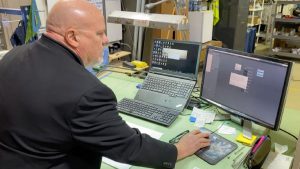DUBLIN, Ohio — Public schools in the U.S. produce 1.9% of food waste, which amounts to 36.5 pounds of food per student each year, according to the National Farm to School Network.
Food waste has been on the minds of Dublin Jerome High School graduates Meghan Bartsch and Kyra Hanes for some time, ever since they took Environmental Science. They decided to start researching, then turned an idea into action, setting the path forward for the arrival of the Grind2Energy recycling system.
In November, Dublin Jerome became the public school in North America to get the machine that turns food waste into natural gas and fertilizer for local farms.
“We were so upset with how much food gets wasted, especially in schools, and we thought after hearing about our teacher’s experience in Cleveland, we thought it would be perfect to put in a school but then it was a matter of, would it work in a school?” said Bartsch.
Environmental Science Teacher Ashley Dulin-Smith was at that conference in Cleveland in 2017, learning about the Grind2Energy system at its use at 100 colleges, hotels and sports arenas across the country.
The three worked together to secure a $70,000 grant from the Ohio Environmental Protection Agency and a 25% match by the Dublin City School District.
“This is a very forward-thinking movement. Legislation has happened around Ohio with requirements for organic diversion. It’s not here yet, but I think that it’s coming, so when it comes, we will be ready for that,” said Dulin-Smith.
Both Dulin-Smith and her former students said they’re proud to be a part of the solution and they hope students will continue to do their part for a greener future.
“We talk about students having grit, and these two students had it. They did most of this with some guidance along the way,” said Dulin-Smith.
“It’s like our baby. We worked on it for four years now and we’re super excited that it’s here. It’s really exciting to see students take an interest in this, and not only take an interest, but also take an interest in other ideas that could help benefit our school and our earth and leave it better than when we found it,” said Hanes.
The Solid Waste Environmental Excellence Protocol said many of the nation’s 2,000 landfills are expected to reach maximum capacity by 2035.
In their research, Dublin Jerome High School found they waste almost 350 pounds of food scraps per day.
Their Grind2Energy system has a 3,000 gallon tank which holds the scraps and liquid. It could take months before the tank fills.




